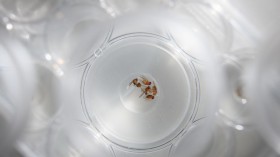The first rock sample picked up by Curiosity rover on Mars shows a varied composition resembling unusual rocks from volcanic areas on Earth, announced NASA.
The rock dubbed as "Jake Matijevic" was assessed using two of rover's scientific instruments to study the chemical composition of the rock. They found that the rock has a different composition that is similar to igneous rocks found on Earth.
"This rock is a close match in chemical composition to an unusual but well-known type of igneous rock found in many volcanic provinces on Earth," said Edward Stolper of the California Institute of Technology in Pasadena, who is a Curiosity co-investigator.
"With only one Martian rock of this type, it is difficult to know whether the same processes were involved, but it is a reasonable place to start thinking about its origin," he said.
Curiosity's Alpha Particle X-Ray Spectrometer (APXS) instrument analyzed two penny-size spots on the pyramid-shaped rock. It found that the rock lacks magnesium and iron minerals, but has higher concentrations of minerals like feldspar, compared to any other igneous rocks examined by other Mars rovers.
"Jake is kind of an odd Martian rock," APXS Principal Investigator Ralf Gellert of the University of Guelph in Ontario, Canada, said.
"It's high in elements consistent with the mineral feldspar, and low in magnesium and iron," he said.
Another instrument called as Chemistry and Camera (ChemCam) also analyzed the chemical composition of the rock using its laser pulses at each 14 target points on the rock. It also suggested that Jake rock has higher concentrations of feldspar. Additional tests will be done to confirm the findings, said mission scientists.
Curiosity is currently in an area called "Rocknest" to collect soil samples from the Martian surface. The first scoop of soil collected was used to clean the internal surfaces of the rover's processing chambers.
The first and second scoop of soil will be discarded. The third and fourth scoop of soil will be analyzed to find their mineral and chemical composition.
The car-sized rover is on a two year mission to find if the environmental conditions on Mars have ever supported microbial life.
© 2024 NatureWorldNews.com All rights reserved. Do not reproduce without permission.





